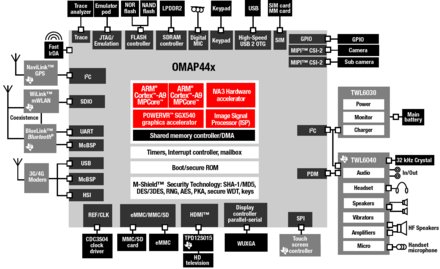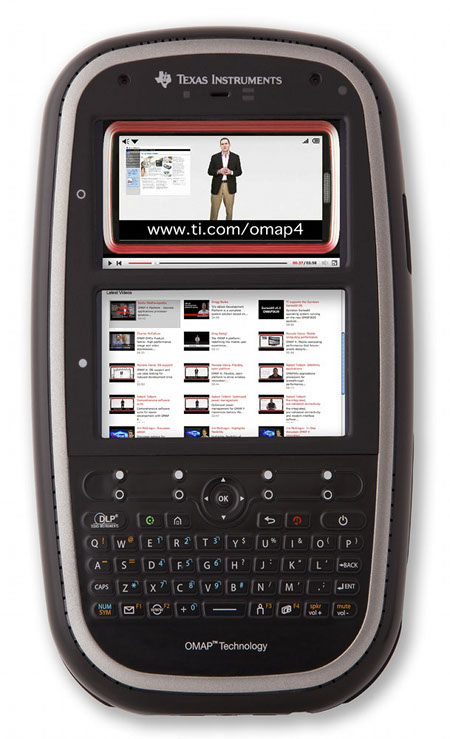TI touts OMAP4 with do-it-all development platform
Feb 15, 2010 — by LinuxDevices Staff — from the LinuxDevices Archive — 6 viewsTexas Instruments (TI) says it is now sampling its OMAP4 mobile application processors, using dual-core versions of ARM's high-end Cortex-A9. The chipmaker is also showing off the Linux- and Android-compatible Blaze, a development platform that sports a pico projector, dual 3.7-inch displays, three cameras, an HDMI output, a compass, plus a barometer and a bevy of other sensors.
The first members of TI's OMAP4 family, the 720MHz OMAP4430 and 1GHz OMAP4440, were announced at the Mobile World Congress (MWC) a year ago, as we reported at the time. These 45nm SoCs (system on chips) are built around ARM's Cortex-A9 processor, which implements the same ARMv7 used on the Cortex-A8 and adds a MPCore interconnect layer for multiple processor support. While as many as four cores are possible (see block diagram, here), the OMAP4 chips use two, as depicted below.

OMAP44x function block diagram
(Click to enlarge)
When it announced the OMAP44x SoCs, TI touted features including the following:
- 10+ hours of 1080p HD video playback
- 4+ hours of 1080p HD record
- 140+ hours of CD quality audio playback
- POWERVR SGX540 graphics engine
- 3D UI support
- Resolutions up to WSXGA (1680×1050)
- HDMI compatible
- 12 x 12 x 0.4mm POP (package-on-package)
- Supports Pico projection technology
With its initial announcement, TI said it would start sampling the OMAP4430 and OMAP4430 during the second half of 2009. Since that time, however, several of the company's competitors have appeared to be catching up. For example, Nvidia last month announced its own dual-core Cortex-A9-based device, the Tegra 250, and NEC has also followed suit with the technically similar Emma Mobile/EV1 and Emma Mobile/EV2.
Now, however, TI says the OMAP4 SoCs are "sampling today," and are on track to be in production in the second half of 2010, as previously announced. To underline this fact and showcase the SoCs' capabilities, the chipmaker is using MWC 2010 to show off "Blaze" (below), a feature-packed OMAP4 development platform manufactured by SVTronics.

The TI/SVTronics Blaze
(Click to enlarge)
The Blaze (above) appears to boast every feature except for the proverbial kitchen sink, including the following:
- Dual 3.7-inch WVGA capacitive touchscreen displays
- HDMI output for connecting a third display
- A built-in pico projector
- Three cameras — one twelve megapixel, and two five megapixel
- Audio support including multiple digital microphones, stereo speakers, and A/V inputs
- A microUSB port
- A "full sensor suite" including an accelerometer, compass, ambient light sensor, barometer, and temperature sensors
- SD and SIM card slots
- Connectivity including WiFi, Bluetooth, FM, and a GPS receiver, all via TI's WiLink 7.0 chip
According to TI, the Blaze also offers developer-friendly functionality such as JTAG ports, trace functionality, plus MIPI test and debug ports. The battery-operable device, whose dimensions and weight weren't specified, will be compatible with Linux, Android, Windows CE, and Windows Mobile operating systems, the company says.
The Blaze development platform
Source: Texas Instruments
(click to play)
Availability
According to TI, its OMAP4430 and OMAP4440 are sampling now to "high-volume wireless OEMs and ODMs," though not via distributors, and will enter production in the second half of this year. The Blaze, meanwhile, is available to select customers today for an unspecified price, and will be generally available by the middle of this year, the company says.
More information on TI's OMAP4 platform may be found here and here. More information on the Blaze may be found here.
This article was originally published on LinuxDevices.com and has been donated to the open source community by QuinStreet Inc. Please visit LinuxToday.com for up-to-date news and articles about Linux and open source.